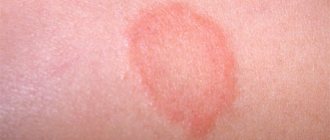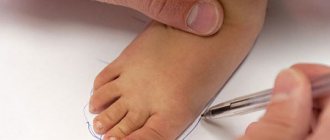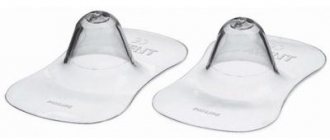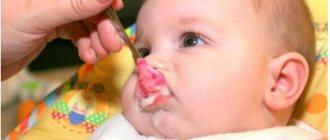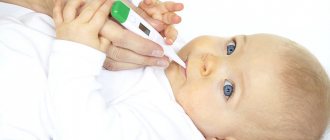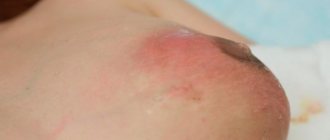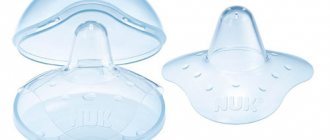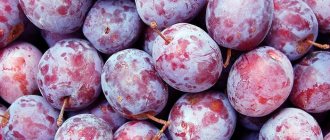It is difficult to imagine caring for a newborn without a feeding bottle.
A large assortment of similar products of different sizes and shapes makes it difficult for parents to choose.
It is worth paying attention to new offers from well-known manufacturers - bottles with an anti-colic effect.
They take into account the peculiarities of feeding, making it as physiological as possible.
What it is?
If the cause of colic is that the baby is swallowing air, it will be easy to correct the situation. The anti-colic bottle allows you to optimize the feeding process so that air does not enter the baby's digestive system.
This device has a special design, thanks to which the nipple is completely filled with nutrition. It usually consists of a bottle equipped with a pressure equalization system, a nipple and a retaining ring. As a result, the baby absorbs only formula or milk. In this case, the risk of swallowing air is reduced to zero.
How do you know if a product with an anti-colic system will help in your case? Watch your child. If after eating his tummy becomes bloated, increased gas formation begins and he begins to cry, then the cause of colic is the wrong approach to feeding. Buy an anti-colic bottle and the problem will be solved.
Other ways to combat colic
Try other methods to get rid of colic:
- diet;
- holding the baby “in a column” after feeding;
- correct attachment to the breast;
- special drink;
- warming;
- massage.
The cause of tummy pain in a baby may be errors in the mother's diet. Review your diet and strictly adhere to the menu prescribed by your doctor. Chocolate, soda, fast food - all this affects the composition of breast milk and the health of the child. Give up your favorite “harmful foods” in favor of the child.
If the baby does not latch onto the nipple correctly, he may swallow air along with the milk during feeding. Consult your doctor about how to properly breastfeed your baby. If the problem is not solved, express the milk into an anti-colic bottle. Don’t forget to hold your baby in a “column” position after feeding – this will allow air to escape freely without causing harm to the digestive system.
Don't forget to massage your baby's tummy regularly. You can do this:
- palm clockwise;
- lift and press the baby’s legs to the stomach several times;
- swing on the fitball, placing the baby tummy down.
The “skin to skin” method also soothes colic, pressing the baby’s bare tummy to the mother’s bare belly. This will calm the baby’s nervous system, and at the same time warm him with “living” warmth.
You can use a warm heating pad or natural wool products, such as a wool sweater.
Fennel decoction, dill water and children's herbal tea will also help relieve the baby of discomfort, but they should be used as a last resort, and only with the permission of a doctor.
As you can see, it is possible to help a child cope with colic, and after three months this unpleasant phenomenon, as a rule, disappears.
Does your baby need an anti-colic bottle?
As pediatricians confirm, 70% of newborns experience flatulence, bloating, painful cramps, and regurgitation. Colic usually appears at one month of age and can last up to 3-4 months (sometimes longer). Their origin is associated with the imperfection of the enzymatic system, poor digestibility of lactose, overfeeding, the use of inappropriate mixtures and the entry of air into the stomach during sucking.
An integrated approach is effective in the fight against colic: warming the tummy, massage, and proper diet. When breastfeeding, it is important that the baby grasps the nipple along with the areola, then he will not swallow air along with the milk. Along with physiotherapy, a good way to prevent gas formation in the intestines is an anti-colic bottle. It cannot solve all tummy problems, but it is a useful accessory that significantly reduces the likelihood of painful attacks and regurgitation.
Which bottle should you choose?
There are many types of anti-colic bottles on the market today. They vary in design, shape, price, materials and sizes.
Typically, the products have a curved shape to optimally fill the nipple with formula or milk. But this does not completely solve the problem, since it does not create a vacuum in the bottle.
In modern devices, a special valve is made. It can be located:
- On the bottom - to open the holes, the bottom is turned.
- In the upper part there are holes in a special ring and the “skirt” of the nipple.
- As part of the reservoir valve system, a special device consisting of an air tube and a ring that supplies air from below.
The effectiveness of the anti-colic system is enhanced by using replaceable or variable flow teats.
Material
When buying an anti-colic bottle for your baby, be sure to study the composition of the product. It should not contain phthalates, PVC, bisphenol.
Do not rely solely on labels; perform a visual inspection to ensure the product is safe. For example, a PVC bottle has a bluish tint, and dents on it become milky.
A high-quality and safe vessel for feeding a child can be made from:
- polypropylene (matte white color);
- polyethersulfone (transparent, but with a golden tint);
- glass;
- surgical silicone.
It is believed that glass products are the safest and most hygienic. But they have several disadvantages - they break often and are quite heavy. They are suitable for home use only. The food in such bottles takes a long time to warm up, but cools down slowly.
Plastic products are lightweight and durable, making them ideal for feeding while walking. But plastic quickly becomes cloudy and changes color under the influence of fruit drinks and juices.
When purchasing, do not hesitate to smell the bottle - there should be no odor coming from it.
Carefully inspect the product: the nipple should be free of stains, cracks, and wrinkles. It is advisable that it has 2-4 holes - this will allow you to regulate the flow of baby food so that your baby can eat comfortably. The bottle itself has no chips or cracks. If a defect is discovered at home, the product should be thrown away immediately.
Capacity
When making a purchase, consider your baby's appetite. Usually, 125 ml of food is enough for babies up to 2 months, while a one-year-old child already needs at least 250 ml.
Do not buy anti-colic bottles with too many divisions on the scale - this does not help, but confuses parents and complicates the process of preparing infant formula.
Anti-colic system
There are two options:
- The simplest bottles are equipped with an air channel in the nipple. They are inexpensive (from 200 rubles), but often leak.
- Devices equipped with a complex system completely eliminate the risk of improper feeding. In addition to the high price, there is another disadvantage: they are difficult to wash. And the accumulation of stale baby food in hard-to-reach areas of the nipple and bottle is a serious danger to the baby’s health.
The best baby bottles for colic
Here are our top picks for baby bottles that can help prevent colic:
Baby bottle Dr. Brown's Original Bottle
There are many specific ways that bottle manufacturers get around the problem of baby gas, but one classic method is to use an internal vent that looks a little like a straw that connects to a screw cap and dangles into the bottle.
A good inner vent bottle will have parts that can be placed in the dishwasher or sterilizer along with the rest of the bottle. The most notable feature of this bottle is the internal ventilation system. Unlike other anti-colic bottles, the vent is not in the nipple, but in the nipple collar, which directs air through the vent back into the milk.
This not only reduces air bubbles in the milk, but also prevents nutrient oxidation resulting in more vitamins C, A and E being retained.
Another way the internal opening helps colicky babies is by eliminating the vacuum that is created in bottles. In this way, it more closely mimics natural breastfeeding—after all, there is never a vacuum in the breast or any pressure that needs to be released.
This allows babies to feed at their own pace rather than dictated by the nipple they are using.
PROS
- The unique internal ventilation system means there is no vacuum in the bottle.
- BPA free
- Dishwasher safe
- Retains nutrients in milk.
MINUSES
- Even more parts to assemble.
- Difficult to wash.
Philips Avent Anti-Colic baby bottles
Some colic bottles are more streamlined because the venting system is built into the nipple itself.
If any air gets into the small holes at the base of the nipple, it will be drawn out and away from your baby's mouth. The advantage of this type of design over straw style vents is that you have one less thing to clean. These Avent anti-colic bottles have just four parts (bottle, teat, ring and cap) that are dishwasher safe.
They are also fully compatible with the rest of the Avent range, so if you have other classic baby bottles, nipples or cups, these parts will be interchangeable and you can use them throughout your baby's early feeding period. All bottles and nipples are BPA free.
The main feature is the unique hole in the nipple that helps release air back to the top of the bottle and away from your baby. It's one thing to hear what a bottle is supposed to do, but it's another thing to hear it backed up by scientific evidence. These bottles have actually been tested and shown to reduce baby's nighttime fussiness by 60% compared to regular bottles.
PROS
- Simple, classic design.
- Easy to clean in the dishwasher.
- Hard nipple to prevent collapse.
- Clinically tested.
MINUSES
- The lowest nipple flow has 2 holes, making it too fast for some children.
- Some parents complained about leakage.
Comotomo baby bottles
You may be one of those moms who noticed an increase in fussiness only after you transitioned from breastfeeding to bottles. While breastfeeding is naturally one way to reduce colic, your baby may have a little more trouble feeding smoothly from a bottle, which isn't as ideal for them as your breast. If you have a baby who struggles with both colic and pacifier problems, you'll need a bottle that has anti-colic properties but also feels very similar to breastfeeding.
These bottles are unique in that both the nipple and bottle are made of flexible silicone. Unlike traditional, hard bottles, this allows the baby to continue feeding continuously if the vacuum pressure is not released.
The wide neck is easy to clean, and the flexible shape means you can reach all parts of the bottle without a brush. But that's not even necessary because you can simply wash all parts in the dishwasher.
The nipple contains dual anti-colic holes, allowing air and pressure to gently release back into the bottle instead of being swallowed by baby and causing gas. These bottles are also available in green and pink, allowing you to choose your favorite color for your baby!
PROS
- All four parts are dishwasher safe.
- Flexible, natural feel
- Compatible handles are available for self-feeding.
- The nipple has one hole
MINUSES
- Flexible shape may make it difficult for baby to grasp.
- It's hard to see the ml measurements on the bottle.
MAM Anti-Colic Bottles
Keeping the air out of the milk in the bottle is all about maintaining pressure and keeping the liquid from aerating. Even if you don't see obvious bubbles in the milk, tiny ones can still form and accumulate in your poor baby's belly. The vented base of the bottle regulates the air pressure inside the bottle and stops your baby from swallowing air.
This bottle has vent holes at the bottom of the bottle, relieving pressure and trapping air bubbles from the milk, reducing cases of gas and colic. The bottle also contains a silicone nipple, which is tasteless, colorless and odorless, plus it is soft and slightly flattened like a natural nipple.
For this reason, this bottle may be a good choice for women who choose to use both breastfeeding and formula feeding. This bottle can help a small baby switch between breast and bottle more easily.
The vent holes on the bottom do mean this bottle has more parts to clean, but the manufacturers have responded to this by designing it to self-sterilize in the microwave in three minutes, meaning you don't need to buy a separate sterilizer.
Studies have shown that 94% of babies accept the brand's bottle, and 80% of parents report a reduction in colic with its help.
PROS
- Self-sterilizing design, so you can steam sterilize it directly in the microwave.
- It's easy for baby to switch between bottle and breast.
- Dishwasher safe
- Very affordable.
MINUSES
- Additional parts mean more parts need to be cleaned.
- Comes with medium flow nipples, so you need to purchase slow flow nipples separately.
Tommee Tippee Closer to Nature Bottles
Swallowing air may be one of the culprits behind colic and tummy problems, but some babies experience a lot of discomfort simply because of the speed at which they drink. Bottle feeding is known to encourage babies to be greedy, especially if the milk flows faster than it would from the breast. If this is a problem for your baby, try finding a bottle with a slower flow.
This Tommee Tippee set comes standard with a low flow nipple, which helps keep your little one from feeding too quickly and causing tummy upsets. In addition to the low flow rate, stage 1 nipples have a valve that allows pressure to escape from the bottle.
These bottles are also designed with a wide base, allowing your baby to breastfeed, reducing the chance of swallowing air. The silicone tip bends like the tip of a natural nipple to further mimic the natural breastfeeding experience.
Accurate volume markers on the side make it easy to see how much your baby is eating and prevent overfeeding, which can cause vomiting, tummy pain and gas. The wide shape of the bottle makes cleaning easy and allows parents to be closer to their baby during feeding.
PROS
- The nipple valve allows the release of air and pressure.
- The nipple curves to simulate breastfeeding.
- Simple design with few details.
- Includes slow flow nipples
MINUSES
- Should not be washed in the dishwasher.
- The pacifier may be too slow
Playtex Ventaire baby bottle
Gas and fussiness can be greatly reduced if you hold your baby in a more upright position while feeding. This helps them open their throats and prevent them from swallowing air, and is also recommended for preventing both indigestion and ear infections. If you find that vertical feeding works best for your baby, you will need a bottle that comfortably supports this position.
This Playtex bottle is angled in such a way that you can hold it quite comfortably while your baby is sitting upright.
Micro-channel vents direct air up and away from baby where they exit from the base. You'll get relief from the symptoms of colic, gas and indigestion without having to clench your hand trying to find a good feeding position.
These bottles are BPA, phthalate and PVC free and come in a variety of nipple shapes. Your baby can choose a specific pacifier shape to fit the contours of his mouth. A good latch forms a tight seal so no air is accidentally swallowed.
These bottles come in 170ml or 270ml sizes with durable caps to keep pacifiers clean and hygienic. The design also means this bottle is ideal for babies transitioning from breastfeeding or switching between breast and bottle.
PROS
- The pacifier is soft and skin-like
- Comfortable to hold in your hands.
- Adjustable flow, great for babies who sometimes choke or gag.
- Wide range of compatible nipples
MINUSES
- The screw cap is a bit fiddly and can cause leakage if not attached correctly.
Munchkin Latch Bottles
Although it sometimes seems like an eternity, your baby won't be bottle feeding for that long and pretty soon he'll be transitioning to a sippy cup and solid foods. If you have an older baby or just like the idea of products that grow with your baby, look for a bottle that can be adapted. Most babies grow out of colic and gas, but if your baby is still fussy, look for transition cups with anti-colic valves.
This brand makes really high quality baby bottles with an anti-colic valve at the base to prevent gas formation. Parents love how much the nipple stretches and moves, giving your baby a more natural feeding experience so they can feed properly.
You can switch to a transition cup later without too much disruption. This cup has a removable handle that's easy for little hands to grab and comes with the same anti-colic mechanism at the base.
As your baby learns to drink from a cup and develops his own feeding technique, you can still be sure that he is not swallowing or inhaling air that will haunt him later. Some moms have discovered that cup handles can also be used on other cups and bottles.
PROS
- The nipple is very flexible
- The ergonomic handle on the cup is removable.
- The durable lid makes them very portable.
- There is a range of compatible nipples
MINUSES
- The flow on the transition cup can be frustratingly slow for some babies and toddlers.
- The transition cup may be too large for some children.
When and how to use?
If the baby is bottle-fed, an anti-colic bottle can be used from birth. For the first month, you will need a low flow pacifier. Gradually the number of holes in the nipple needs to be increased.
This bottle will also be useful for breastfed babies who do not want to latch onto their mother’s breast correctly - you can express milk into the container. Finally, the device will be useful for the child if the mother needs to leave for a while. Then the relatives will be able to feed the baby themselves. You can use an anti-colic bottle until the baby is completely switched to solid food.
Some parents are worried whether such a bottle will wean a mixed-fed baby from his mother’s breast? Such fears are unfounded. Just buy a pacifier with one small hole. Then the baby will have to put in the same amount of effort to get the required amount of food.
How do you know if the bottle you buy is right for your baby?
- Firstly, he should eat with pleasure, without interruption. This means that he is comfortable and comfortable.
- Secondly, there will be no food remaining in the container. If the baby constantly does not finish eating, it means that at the moment the bottle is “too big” for him and it is better to put it aside for the future.
What else to consider when choosing
Having figured out how many containers are needed to feed a baby and clarified what they can be, it will not be superfluous to get information about what else you should pay attention to when choosing such baby products as a thermal bottle or an anti-colic system. We are talking about the following points:
- neck diameter (ideally, if it is the same - you won’t have to select a separate suitable nipple for each container);
- shape of the container (should fit into the baby’s hands);
- presence of handles;
- manufacturer (it is recommended to refuse to purchase products from unknown companies with products of questionable quality).
Manufacturers offer a wide selection of anti-colic bottles, prices vary from budget to quite high. When purchasing, you need to pay attention to several points.
Even if the baby is breastfed, the device may be needed for water, as well as at times when the mother will have to leave for some time.
That is why today we decided to understand such a difficult issue as feeding bottles for newborns: which ones are best suited for formula and milk, and how to make the right choice.
We follow the rules
Each anti-colic bottle comes with an instruction manual. But it definitely won’t hurt to find out general recommendations for new mothers and fathers.
- Sterilization. Before use, the glass container should be thoroughly rinsed and then boiled for at least 5 minutes. Another option is to keep it in a sterilizer. Plastic products are disinfected only in sterilizers. Some models can be processed in the microwave. These bottles have a special lid into which you need to fill with water and put the pacifier there. Keep the bottle in the microwave for several minutes. After the procedure, the pacifier is removed with special forceps.
- Cleansing. After the child has eaten, remove any remaining food from the bottle and then rinse with a brush or sponge. The product should be stored open for free air circulation.
- Valves. Check the integrity of the valve and its parts before each feeding.
- Pacifier. Periodically inspect the pacifier, stretching it in different directions. A child-safe product will not have cracks or signs of deformation. It is recommended to change the pacifier at least once every 2-3 months.
- Storage. Bottles should be stored at room temperature. Moreover, the pacifier is covered with a lid.
If, in addition to an anti-colic bottle, you are planning to buy a sterilizer, a bottle warmer or a special thermos for baby food, try to give preference to one manufacturer. The fact is that not all containers are universal in shape. Some bottles may simply not fit into the heater opening, while others will experience uneven heating.
Precautionary measures
- Do not trust silicone indicators - they do not always give true information. Monitor the temperature of the anti-colic bottle and baby food yourself.
- The bottle and its contents cannot be heated in the microwave. In this case, the temperature is distributed unevenly, which can cause the child to get burned.
- Do not use products with chips, cracks, or scratches - pathogens accumulate in them. Throw away defective products without regret.
- Expressed breast milk can be stored in a bottle for no longer than two days.
- It is not advisable to pour juices and compotes into plastic containers - colored drinks stain the products and become cloudy.
- Bottle nipples cannot be used as pacifiers.
- The child is prohibited from playing with the components.
Review of popular brands
We present to your attention a mini-review of the most popular and convenient models. A brief description will help you understand the main characteristics of anti-colic bottles, as well as the approximate cost of the product and choose the appropriate model.
Adiri Breastbottle
The nipple is made of surgical silicone, has 3 holes, which allows you to adjust the flow rate. The container has a stable base, a valve located at the bottom, and a wide neck. On sale you can find products of different sizes. This allows you to choose a bottle to suit your baby's appetites.
EasyStart
They are made from either glass or polypropylene. The silicone nipple is equipped with a valve. The bottle capacity is either 120 ml or 240 ml.
Philips Avent Classic and Natural
Products with a regular valve. Made of polypropylene, have a capacity of 125 ml, 260 ml, 330 ml. Silicone nipples can be purchased as your baby grows.
Bibi
The bottles are either cylindrical glass or polypropylene, tapering in the middle. The products have three volume options: for newborns - 125 ml, as well as 250 ml and 350 ml for older children. The valve is located in the silicone nipple. An important advantage is the nipple with adjustable flow.
Dr Brown
There are two types of necks: wide and narrow. Products made from propylene are tapered in the middle or cylindrical. The anti-colic system consists of a sleeve, a funnel and a tube. The kit includes a brush for cleaning.
Tommee Tippee
Products made from polypropylene of this brand are very popular. The anti-colic system has a tubular valve and a ventilation ring. The tube also detects the temperature of the mixture and indicates overheating by changing color.
How to make the right choice?
The main criteria when choosing bottles are their safety for the baby and ease of use. Before you buy a product, check what material it is made of. Assess the volume of the bottle and its shape, carefully examine the nipple. It is also necessary to find out how durable the product is and whether it can withstand heat treatment. On the Internet you can read reviews from parents and compare prices.
The size of the bottle depends on the age of the child. For a newborn baby, a small container is enough - no more than 150 ml. And when the child grows up, he will need another bottle - a larger one.
Important!
When purchasing a baby bottle, be sure to pay attention to the composition of the material. A quality product should not contain PVC, phthalates, or bisphenol. It is advisable to give preference to glassware, polypropylene, surgical silicone, and polyethersulfone. The most hygienic is, of course, glass. But glass bottles have their drawbacks - heavy weight and fragility.
Reviews from parents
Most mothers and fathers agree that an anti-colic bottle is useless only if the baby's colic is caused by other reasons other than swallowing air. Typically, parents note that after using such devices, their child’s condition improves.
Tatyana Popova, Ekaterinburg. The colic started after the milk ran out and my son had to be switched to formula. I thought it was just a change in diet. But then I was advised to take an Avent bottle, and the child felt better. Over time, I replaced it with the Brown anti-colic system - also a good result. Ekaterina Nedopekina, Novosibirsk. We tried many bottles, nothing helped. They treated him with heating pads on his stomach and massage.
Svetlana Glotova, Yaroslavl. My daughter had regurgitation. I didn’t want to breastfeed normally, no matter how much I suffered. I bought an anti-colic bottle and it helped. The valve slowly lets air in, so my daughter ate without stopping. No colic, no belching. And the bottle is easy to clean - the neck is wide.
Natalya Efimtseva, Barnaul. We used different models. The manufacturer is not important, but take glass ones! They are easier to clean, can be boiled, and last a long time. She also gave her a massage and wrapped her in an angora jacket after feeding. Bottles alone will not help - you need to watch your diet, keep it warm, and don’t be lazy about doing a massage!

